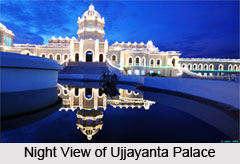 Architecture of Ujjayanta Palace deals with the modern sculptural art of royal times. This palace was once the royal abode of Tripura kings and later it served as the State Legislative Assembly of Tripura.
Architecture of Ujjayanta Palace deals with the modern sculptural art of royal times. This palace was once the royal abode of Tripura kings and later it served as the State Legislative Assembly of Tripura.
Ujjayanta Palace is white in colour. This building has a great similarity with the architectural works in London. Ujjayanta Palace served as a dwelling place to many past rulers of Tripura since it was built in the year 1901, by the British reality firm.
Ujjayanta Palace was built in the Indo-Saracenic style with a Mughal inspired spacious garden and lake spread out in front. The two-storied high building of white colour has three domes, each measuring 86 feet high. The interior of Ujjayanta Palace has beautiful tiles floor, carved wooden ceilings and doors. The palace and its surroundings covered an area of 1 sq. km. and housed many temples dedicated to Hindu Gods and Goddesses.
The compound of Ujjayanta Palace covers an area of approximately one square kilometre. The main block of Ujjayanta Palace covers 800 acres of land. This main block of Ujjayanta Palace comprises public halls such as the Throne room, the Durbar hall, Library and the Reception hall.
The Neoclassical palace of Tripura lies in the heart of the state capital; Agartala was designed by Sir Alexander Martin of Messrs Martin and Company. The Chinese Room of Ujjayanta Palace is particularly notable for the ceiling of which was crafted by artisans brought from China.
Ujjayanta Palace has a mixed type of architecture. The two-storied palace of Ujjayanta has three large domes, the largest of which is 86 ft high from the ground. It rests atop a four-storied central tower. The palace has tiled floors and carved front doors. The newer attractions of Ujjayanta Palace are the musical fountains installed in front of the main entrance, and the night-time floodlights.
The grounds of Ujjayanta Palace are laid out as formal Mughal gardens adorned with fountains. There are two large artificial ponds on either side of the garden which is decorated with pools and fountains. Several Hindu temples are located very adjacent to Ujjayanta Palace, dedicated to Lakshmi Narayan, Uma-Maheshwari, Kali and Jagannath.



















